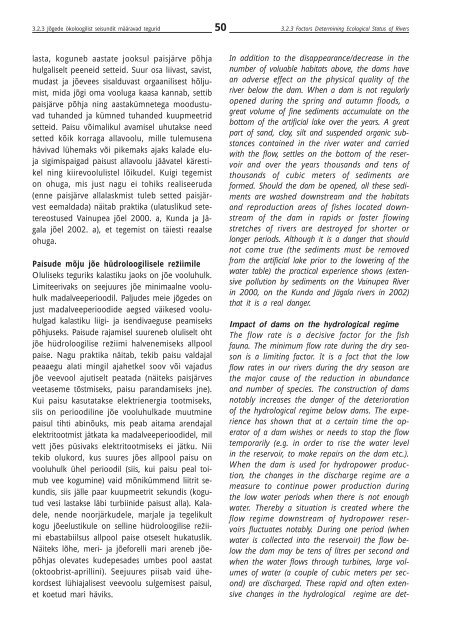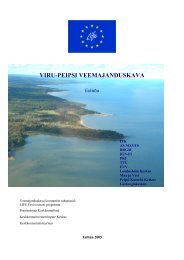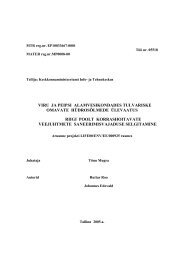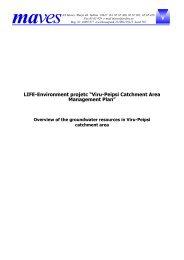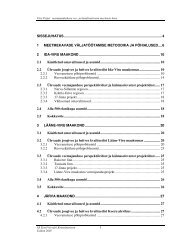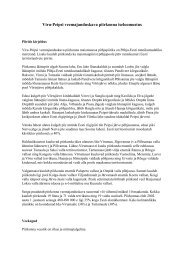Viru-Peipsi veemajanduskava - Keskkonnaministeerium
Viru-Peipsi veemajanduskava - Keskkonnaministeerium
Viru-Peipsi veemajanduskava - Keskkonnaministeerium
You also want an ePaper? Increase the reach of your titles
YUMPU automatically turns print PDFs into web optimized ePapers that Google loves.
3.2.3 Jõgede ökoloogilist seisundit määravad tegurid<br />
50<br />
3.2.3 Factors Determining Ecological Status of Rivers<br />
lasta, koguneb aastate jooksul paisjärve põhja<br />
hulgaliselt peeneid setteid. Suur osa liivast, savist,<br />
mudast ja jõevees sisalduvast orgaanilisest hõljumist,<br />
mida jõgi oma vooluga kaasa kannab, settib<br />
paisjärve põhja ning aastakümnetega moodustuvad<br />
tuhanded ja kümned tuhanded kuupmeetrid<br />
setteid. Paisu võimalikul avamisel uhutakse need<br />
setted kõik korraga allavoolu, mille tulemusena<br />
hävivad lühemaks või pikemaks ajaks kalade eluja<br />
sigimispaigad paisust allavoolu jäävatel kärestikel<br />
ning kiirevoolulistel lõikudel. Kuigi tegemist<br />
on ohuga, mis just nagu ei tohiks realiseeruda<br />
(enne paisjärve allalaskmist tuleb setted paisjärvest<br />
eemaldada) näitab praktika (ulatuslikud setetereostused<br />
Vainupea jõel 2000. a, Kunda ja Jägala<br />
jõel 2002. a), et tegemist on täiesti reaalse<br />
ohuga.<br />
ˆ<br />
Paisude mõju jõe hüdroloogilisele reziimile<br />
Oluliseks teguriks kalastiku jaoks on jõe vooluhulk.<br />
Limiteerivaks on seejuures jõe minimaalne vooluhulk<br />
madalveeperioodil. Paljudes meie jõgedes on<br />
just madalveeperioodide aegsed väikesed vooluhulgad<br />
kalastiku liigi- ja isendivaeguse peamiseks<br />
põhjuseks. Paisude rajamisel suureneb ˆ<br />
oluliselt oht<br />
jõe hüdroloogilise reziimi halvenemiseks allpool<br />
paise. Nagu praktika näitab, tekib paisu valdajal<br />
peaaegu alati mingil ajahetkel soov või vajadus<br />
jõe veevool ajutiselt peatada (näiteks paisjärves<br />
veetaseme tõstmiseks, paisu parandamiseks jne).<br />
Kui paisu kasutatakse elektrienergia tootmiseks,<br />
siis on perioodiline jõe vooluhulkade muutmine<br />
paisul tihti abinõuks, mis peab aitama arendajal<br />
elektritootmist jätkata ka madalveeperioodidel, mil<br />
vett jões püsivaks elektritootmiseks ei jätku. Nii<br />
tekib olukord, kus suures jões allpool paisu on<br />
vooluhulk ühel perioodil (siis, kui paisu peal toimub<br />
vee kogumine) vaid mõnikümmend liitrit sekundis,<br />
siis jälle paar kuupmeetrit sekundis (kogutud<br />
vesi lastakse läbi turbiinide paisust alla). Kaladele,<br />
nende noorjärkudele, marjale ja ˆ tegelikult<br />
kogu jõeelustikule on selline hüdroloogilise reziimi<br />
ebastabiilsus allpool paise otseselt hukatuslik.<br />
Näiteks lõhe, meri- ja jõeforelli mari areneb jõepõhjas<br />
olevates kudepesades umbes pool aastat<br />
(oktoobrist-aprillini). Seejuures piisab vaid ühekordsest<br />
lühiajalisest veevoolu sulgemisest paisul,<br />
et koetud mari häviks.<br />
In addition to the disappearance/decrease in the<br />
number of valuable habitats above, the dams have<br />
an adverse effect on the physical quality of the<br />
river below the dam. When a dam is not regularly<br />
opened during the spring and autumn floods, a<br />
great volume of fine sediments accumulate on the<br />
bottom of the artificial lake over the years. A great<br />
part of sand, clay, silt and suspended organic substances<br />
contained in the river water and carried<br />
with the flow, settles on the bottom of the reservoir<br />
and over the years thousands and tens of<br />
thousands of cubic meters of sediments are<br />
formed. Should the dam be opened, all these sediments<br />
are washed downstream and the habitats<br />
and reproduction areas of fishes located downstream<br />
of the dam in rapids or faster flowing<br />
stretches of rivers are destroyed for shorter or<br />
longer periods. Although it is a danger that should<br />
not come true (the sediments must be removed<br />
from the artificial lake prior to the lowering of the<br />
water table) the practical experience shows (extensive<br />
pollution by sediments on the Vainupea River<br />
in 2000, on the Kunda and Jägala rivers in 2002)<br />
that it is a real danger.<br />
Impact of dams on the hydrological regime<br />
The flow rate is a decisive factor for the fish<br />
fauna. The minimum flow rate during the dry season<br />
is a limiting factor. It is a fact that the low<br />
flow rates in our rivers during the dry season are<br />
the major cause of the reduction in abundance<br />
and number of species. The construction of dams<br />
notably increases the danger of the deterioration<br />
of the hydrological regime below dams. The experience<br />
has shown that at a certain time the operator<br />
of a dam wishes or needs to stop the flow<br />
temporarily (e.g. in order to rise the water level<br />
in the reservoir, to make repairs on the dam etc.).<br />
When the dam is used for hydropower production,<br />
the changes in the discharge regime are a<br />
measure to continue power production during<br />
the low water periods when there is not enough<br />
water. Thereby a situation is created where the<br />
flow regime downstream of hydropower reservoirs<br />
fluctuates notably. During one period (when<br />
water is collected into the reservoir) the flow below<br />
the dam may be tens of litres per second and<br />
when the water flows through turbines, large volumes<br />
of water (a couple of cubic meters per second)<br />
are discharged. These rapid and often extensive<br />
changes in the hydrological regime are det-


